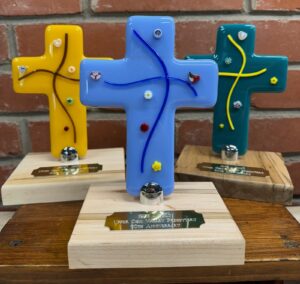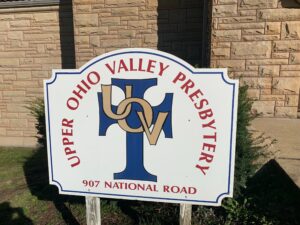
These commemorative crosses will be given out to each church in Upper Ohio Valley Presbytery as part of the mid council’s anniversary celebration at its late October meeting.
For Paul Todd, Upper Ohio Valley Presbytery has always been an integral part of his life. At a young age, he can remember sprawling out on the living room floor with other members of the family piecing together presbytery packets for an upcoming meeting. Paul’s mother, Donna, was the administrative assistant for the presbytery for 26 years and would often bring her work home with her knowing she had some willing, free labor at her disposal.
Fast forward five decades and Paul’s wife, Shawn, is now that person in charge of the secretarial tasks at the presbytery office. To say the Todd family has been there every step of the way during Upper Ohio Valley’s 50 years of existence would not be an understatement.
“I was raised with the presbytery,” Paul said. “I have always considered the presbytery a sibling because my mom, Donna Todd, was the first executive’s assistant. Presbytery has always been a part of my life from the time we were kids in junior high and high school.
“A common day for us in the evening was, we came home from school, mom came home from the presbytery office, we ate dinner together, and then we sat in front of the TV with presbytery packets spread across our living room floor and put them together with mimeograph ink all over the place. What makes this presbytery for me special is that it’s always been so intricate in our lives.”
The importance of the presbytery’s impact on many in the region goes way beyond the Todd clan. That 50 years of tradition is being honored throughout 2023 and reached a crescendo at Upper Ohio Valley’s late October presbytery gathering when the anniversary of the presbytery’s formation was celebrated. That gathering at Vance Memorial Presbyterian Church in Wheeling, WV, included a dinner, special presentations and a commemorative gift to every church in the presbytery.
Presbytery historian the Rev. Gene Toot was an integral part of the festivities as he recounted the region’s historical highlights and reflected on what life was like 50 years ago when the presbytery was created. Gene and others have been sharing details regarding the presbytery’s history at presbytery meetings throughout the year.
“Gene is going to be giving us some added history and be reflecting on some of the things that are kind of not on the books,” said Paul, one of the members of the presbytery’s seven-member Anniversary Commission, prior to the event. “He’ll relate back to the time when the presbytery started, what was going on and the ideology behind it. Usually you get hard statistical facts, but the general feel behind it is what I was looking for and Gene’s been paramount on that because he was there when the presbytery was originally put together.”
In 1971, it was ordered by the General Assembly of the United Presbyterian Church that a reorganization of the denomination’s mid councils occur. With a region along the northern part of the Ohio River deemed as a logical area to form a presbytery, Upper Ohio Valley Presbytery was created, encompassing churches from multiple synods and presbyteries in the area in both Ohio and West Virginia.
“For many years,” Gene wrote in 2017 as part of the Synod of the Trinity’s 300th anniversary celebration, “Presbyterians on both sides of the upper Ohio River had recognized it made little sense that metropolitan areas such as Wheeling/Martins Ferry, Steubenville/Weirton and East Liverpool/Chester were divided not only by a presbytery but also by a synod line. When it became evident that many presbytery lines would be changed, discussions began about forming a presbytery that would include both sides of the river. It was no small task; it involved three synods (Ohio, West Virginia and Pennsylvania) and four presbyteries (Muskingum, Steubenville, Wheeling and Parkersburg).”
“A quote from Gene is ‘To form this new presbytery we had to get two synods and three presbyteries to all agree,’” Paul added with a chuckle. “That is the kind of feel that I’m talking about. It’s hard to read that in the history, to get that understanding.”
 With Upper Ohio Valley Presbytery bordering both the Synod of Pennsylvania-West Virginia (as Trinity was called at the time) and the Synod of the Covenant, the next big decision by the presbytery was to decide to which synod it would belong. After a year of discernment, the presbytery made its decision.
With Upper Ohio Valley Presbytery bordering both the Synod of Pennsylvania-West Virginia (as Trinity was called at the time) and the Synod of the Covenant, the next big decision by the presbytery was to decide to which synod it would belong. After a year of discernment, the presbytery made its decision.
“The fact that we’re in the Synod of the Trinity was really unlikely,” Paul said. “The reason they headed toward the Pennsylvania side of the Ohio River was because we felt we had a closer connection to the Pittsburgh area. A lot of our business came from Pittsburgh and extended here to the Ohio Valley. Our culture, a lot of it, came from Pittsburgh. Our medical stuff – you went to Pittsburgh hospitals. So many areas of our daily living were connected with the Pittsburgh area.
“That was one of the deciding factors on why we decided to go with the Synod of the Trinity because Pittsburgh was in the Synod of the Trinity. The Synod of the Covenant enveloped more of the Columbus area. Columbus was too far away for most of us. Proximity had a lot to do with it, where people here in the Valley went for all of life things. When you had something that had to be done you went to Pittsburgh.”
When Upper Ohio Valley Presbytery joined the Synod of Pennsylvania-West Virginia, a new synod name had to be created because the region now also included six counties in Ohio. With three states encompassing the area, “Trinity” – meaning “a group of three” – was a logical name to affix to the region.
Upper Ohio Valley Presbytery is unique in that it includes parts of two states, with six counties from each state making up the presbytery. While that might seem like a troubling situation for some, the closeness of the region and its people is not affected by state lines.
“There’s a great family relationship between the residents of both states right here because the Ohio River splits us,” Paul said. “The river isn’t so much a barrier. We have a lot of bridges. We are so connected, and I think that that says more about anything. We are family on both sides of the river. It doesn’t divide us, it connects us.”
“The unifying factor was the river,” added John Harris, the current moderator of the presbytery, “because in many ways it’s the Ohio River that both unites us and separates us.”
The interstate relationships are just part of what makes Upper Ohio Valley Presbytery special.
“What makes us unique is that we are a presbytery with churches in two states,” John said. “My hunch is we’re pretty closely evenly divided. One of our largest churches is in West Virginia and the other is in Ohio, so that balances things out right away.
“What I have not felt in this presbytery is a sense of discrimination. We’re very attentive trying to make sure we have a balance of committee members from both West Virginia and Ohio as well as a balance of clergy and elders. We try to move meetings around the presbytery so that we are not meeting in one state more or less than the other.”
John added that the people in the region, even though they may be divided by state lines, are similar in personality and beliefs. The only exception could be the sports teams they root for, and while John said that the Upper Ohio Valley is definitely “Steeler Country,” he added that the people’s college fandom is often split between Ohio State University and West Virginia University, but this is not something that divides the region.
One hurdle for a presbytery comprised of two states could be the state-run organizations with which the presbytery works. For instance, Ohio and West Virginia both have their own Council of Churches, but according to John this has not been an issue in Upper Ohio Valley Presbytery.
“It’s not been a problem because that’s not something that’s been on the top of the agenda for most folks,” he said.
As is the case with any body of the church, issues arise that need addressed. What struck Paul as ironic was that when he came across a document from 50 years ago that outlined some of the sticking points with the churches in the presbytery, they were eerily similar to those that disrupt congregations today.
“An original document has a paragraph about the issues that the presbytery was interested in addressing,” he said. “What was so interesting to me was most of the issues that they were addressing were social issues, issues of justice and issues of economics in the area. They were facing so many things that are relevant to today. The issues that they were facing then may have changed a little bit as far as what they look like on the surface but deep down they are the same issues that presbytery is facing today.”
It all adds up to a region rooted in faith that hasn’t let a river that’s also a state border divide them.
“We’re not as large as we once were, we don’t have as many churches, we don’t have as many members, we don’t have the budget, we don’t have the staff that we did, but what presbytery does?” John said. “Our churches are still doing mission, the word is still being preached, churches are still worshiping and serving, and some are growing. God’s hand is still active and present.”
For Paul, he doesn’t have to go far to feel the impact the presbytery has had on others’ lives. He recently attended the Wee Kirk Northeast Conference for clergy and lay leaders, and it’s there that he hears about the effect Upper Ohio Valley Presbytery has had on various church leaders from around the area.
“A lot of people that I was there at the conference with were people that I have known at different periods in my life growing up here in the presbytery,” Paul remarked. “It kind of gave me a better sense of our connections and how small the world is even though it seems so big. That is particularly where I see God at work because when God brings us together, it doesn’t matter where we’re at, we are still family. And I’ve always gotten that sense here at Upper Ohio Valley Presbytery.
“We’re looking forward to another 50 years of being the gospel of Jesus Christ in the Valley,” Paul concluded.
